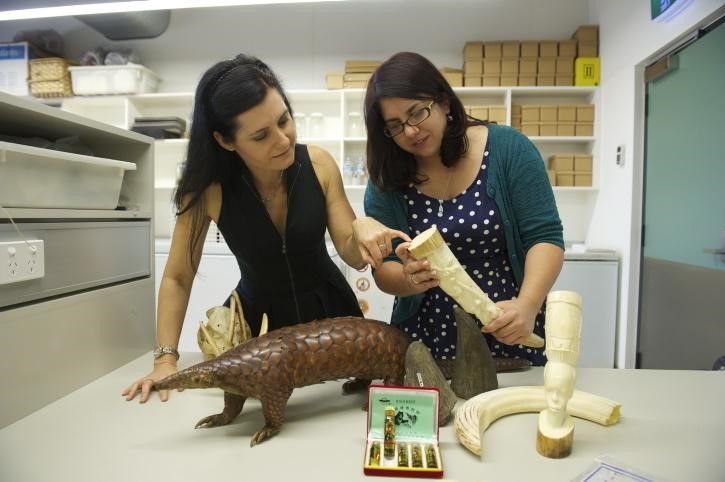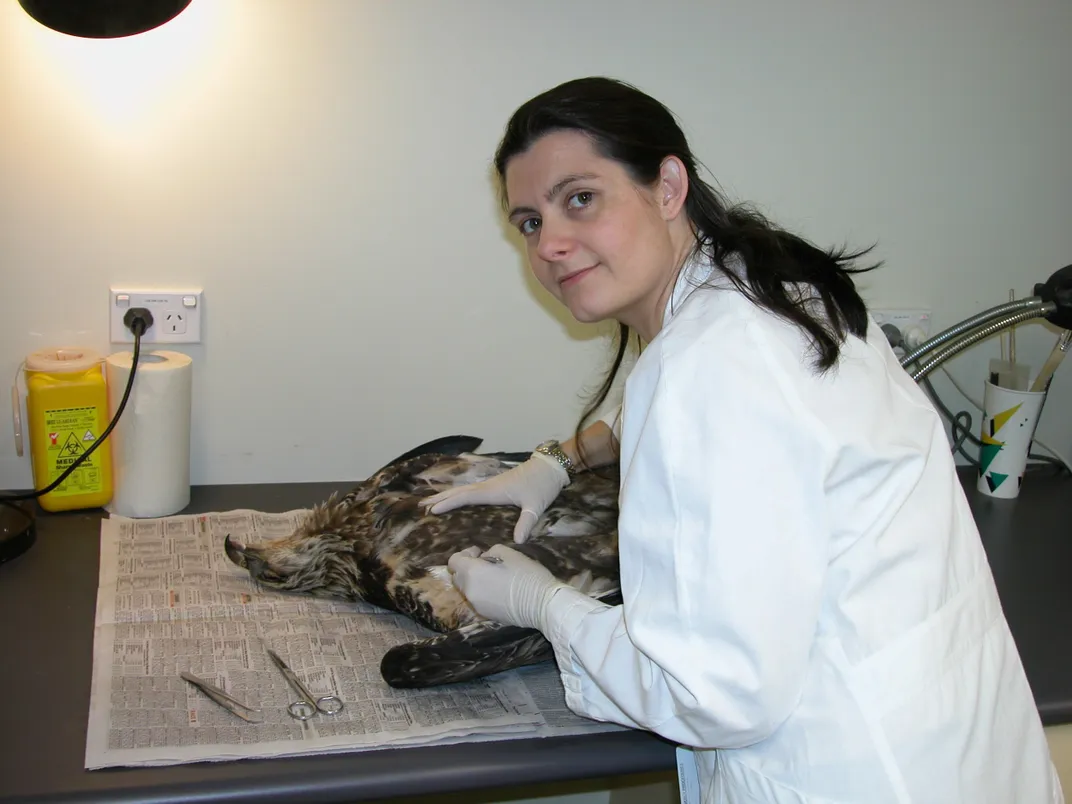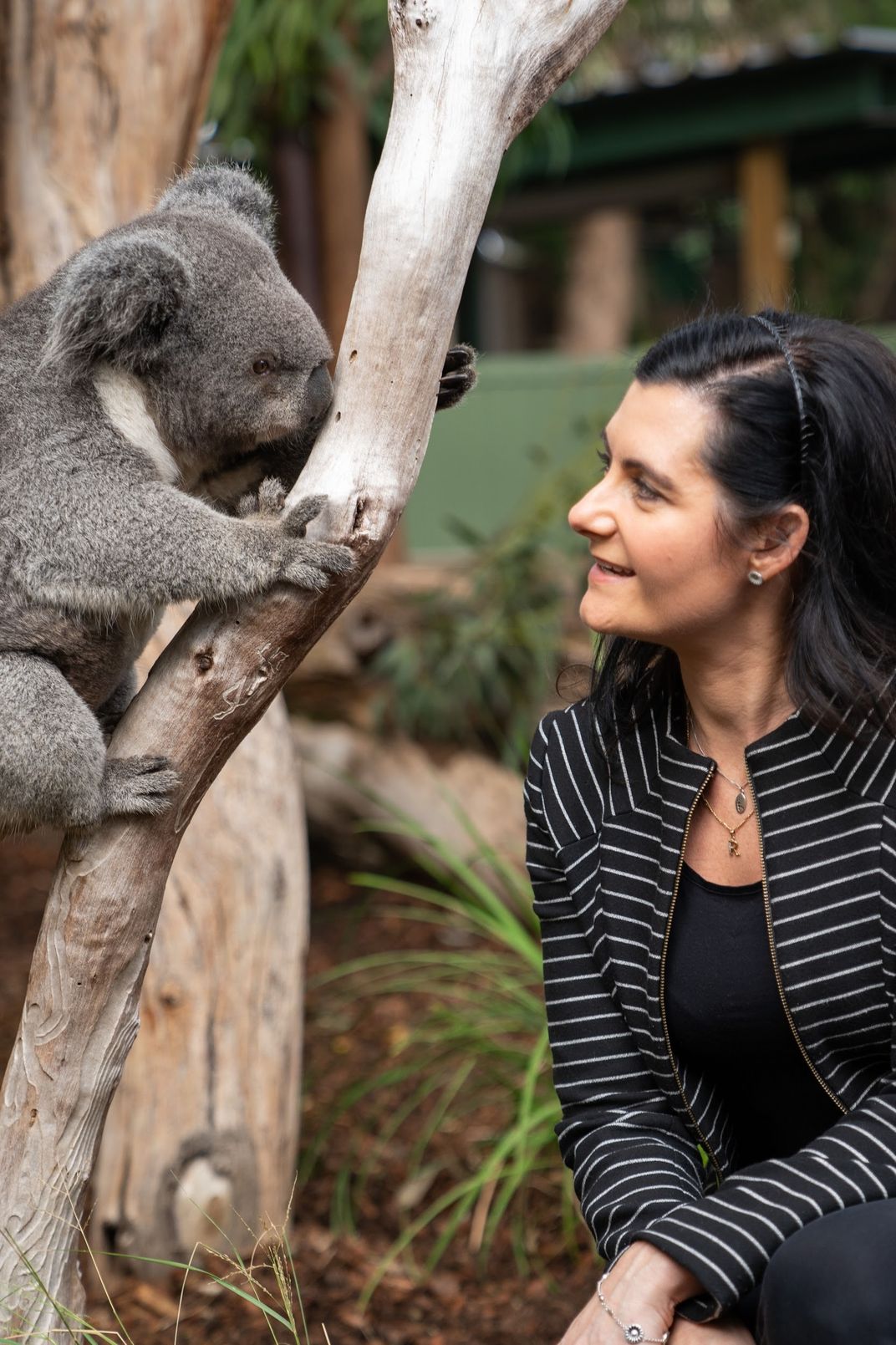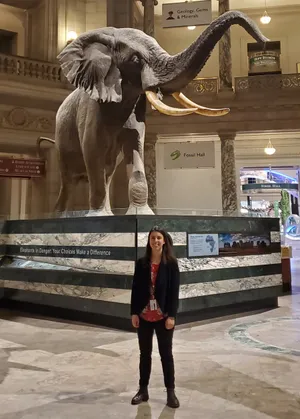NATIONAL MUSEUM OF NATURAL HISTORY
Meet the Smithsonian’s Newest Chief Scientist
Get to know the woman leading science at the Smithsonian’s National Museum of Natural History.
:focal(1250x863:1251x864)/https://tf-cmsv2-smithsonianmag-media.s3.amazonaws.com/blogging/featured/Person_standing_with_its_back_to_a_taxidermied_African_elephant.jpg)
Dr. Rebecca Johnson wandered through the Smithsonian’s National Museum of Natural History last month and paused for a moment to admire the elephant in the rotunda. It began to sink in that she now leads scientific research at the world's largest natural history museum.
Johnson is a wildlife forensic scientist and conservation geneticist. She’s worked with a variety of animals, including koalas. In 2018, Johnson led the sequencing of the entire koala genome as co-chief investigator of the Koala Genome Consortium.
Before working at the Smithsonian, Johnson spent 16 years at the Australian Museum, where she was the first female director and chief scientist in the museum’s almost 200-year history.
In the following interview, Johnson tells us more about her new role and what her goals are as the Smithsonian’s newest Chief Scientist.
What excites you about working at the Smithsonian? And what does it mean to you to help shape scientific research at the museum with the world's largest natural history collection?
What’s most exciting is having both a team of talented scientists and the world’s largest natural history collection. There are specimens in this collection that help us understand how the earth was formed and what the biodiversity of the planet is. Even if you don't yet love museums, you can't help but be excited by the concept that everything we know, everything we've ever collected or learned about the world can somehow be represented by what's in these walls.
And, equally, the fact that we get 5 million visitors a year who we can talk to passionately about what we do when they may or may not have access to science in any other way. Something that's really special about museums in general, but particularly about the Smithsonian, is that we can access knowledge for pretty much anything you're interested in for free, which is pretty amazing.
/https://tf-cmsv2-smithsonianmag-media.s3.amazonaws.com/filer_public/8f/71/8f711174-32a6-4663-aa3f-b9a6a8819b32/person_standing_in_an_exhibit_of_taxidermied_mammals.jpeg)
What are your goals for your new role as Chief Scientist at the National Museum of Natural History?
I’d say my number one goal is amplifying what we do: why we collect things, why we have 146 million specimens and why something that was collected 100 years ago might be valuable and relevant today to help us learn about the world.
I was talking to one of my colleagues last night in Australia who works on rock-wallabies. We have a collection of brush tailed rock-wallabies here at the Smithsonian from the early 1900s, and one of those specimens is from a location where no one knew they occurred—they went locally extinct before records were kept about the distribution of this species.
Now, unfortunately, this species is endangered. And if we end up in a position where we want to reintroduce them into the wild, specimens like ours from 100 years ago fill in knowledge gaps for the population that once existed and help scientists protect them for the future. That's just one example from our approximately 146 million specimens at the museum.
How has research at the museum changed during the COVID-19 pandemic? And why is it important to continue doing science even in a crisis like this?
It is times like the current pandemic that we are reminded how important it is to be informed by science. At the National Museum of Natural History, we are lucky to be able to draw on our expert scientific knowledge, particularly what we have learned from the past, to help us understand what’s happening today. This is what the museum specializes in, investigating our past to understand our present and work to a better future.
Right now, a lot of our research continues remotely. While we don’t have access to our physical collections, thanks to our leadership in digitizing and imaging our collections, some of our specimens are already available virtually. This will be a big focus for us in the future as we can see how widely it benefits the community.
What inspires you as a scientist?
I love the idea that what I do might make a difference. It might improve people's lives in some way, improve the conservation of our wildlife or improve people's understanding of other cultures to make us more inclusive as people.
We’ve massively changed the environment in only a couple hundred years. At the museum, we have the tools for fixing what we might have ‘broken’ during the Age of Humans. We have the data to understand or predict our impacts in a lot of cases. And we also have the knowledge to advise on how we can make it better. We have a lot of incredible people here who have dedicated their entire careers to learning more about the world. I think the ability to use the knowledge and collections that we have in museums to make a difference is what inspires me most to be a scientist.

Can you talk a little bit about your work at the Australian Museum?
My time in Australia was absolutely incredible because I was lucky enough to work in the Australian Museum! I went from being a junior staff member to building labs and research programs and taking on more and more leadership. I was ultimately able to balance both research and leadership – something I still strive for today. As a science leader, I realized my research experience gave me a unique understanding to make researchers’ lives smoother and give them a voice. I found that some of the most fulfilling opportunities were around mentoring young researchers who are the absolute superstars of the future and developing partnerships with universities.
Something I discovered early on (and found very cool) was combining genetic techniques and the collection to help with real world problems like identifying bird strikes. I had heard about the Smithsonian’s bird strike program, which was started by Roxie Laybourne, and was completely inspired to replicate a version of it in Australia.
It was deeply fulfilling to see a fairly traditional industry like aviation embrace science. And it was completely inspired by what’s already done here at the Smithsonian on a massive scale.

You were the first female director at the Australian Museum. Why is it important to have women in STEM fields and leadership positions?
Everyone brings their own lived experience to the leadership table. When we increase diversity, leaders have a broader cross section of knowledge to draw upon and share with their peers. A simple example — which I’m sure many have experienced — was many years ago, one of my senior team members was planning a conference and was mortified when I pointed out to him that all his invited speakers were male. He changed this straight away and was embarrassed it hadn’t been on his radar but grateful I had brought it to his attention.
When I announced my departure from the Australian Museum to come here, I was overwhelmed by the number of people who came up to me and said because they saw me leading an organization, they saw themselves in that role in the future. I also had other young women come up to me and say that they had no idea that I was the first woman, because — to them — it was normal. That's pretty amazing.
Once you start to see yourself as a role model, then you realize just how much better leadership could be if we had many different perspectives represented. A great goal is to have leaders who come in all shapes and sizes and from all backgrounds.

What advice would you give to your younger self or what advice would you give to future female leaders?
Don't let others define you or your story. Particularly if you're a voice that no one's heard before, or you don't look like what people expect you to look like as a leader, scientist or expert. It’s easy for people to have a narrative for you. Your story is yours, even if it is difficult at times. Stay strong, keep on your path and have confidence in what you know is in your core.
Related stories:
Get to Know the Leading Ladies of Science at the Smithsonian
Digitization Allows Public Access to Smithsonian's Hidden Collections
'One Health' Could Prevent the Next Coronavirus Outbreak
Seven Ways to Learn About Natural History From Home

